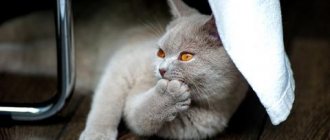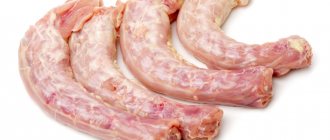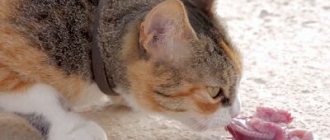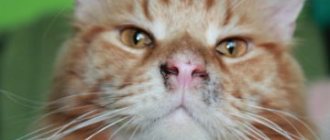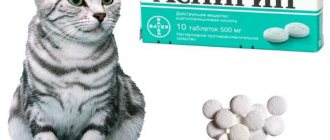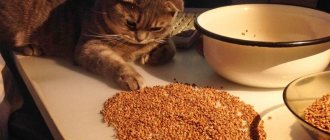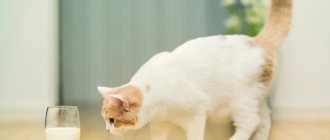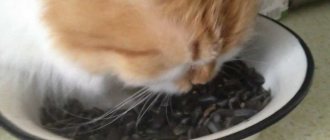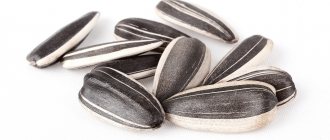Eggs are a valuable product containing many nutrients, amino acids and proteins. Including eggs in your cat's diet will bring significant benefits to her body. Is it possible to give your pet raw or boiled eggs and how often? Cats are carnivores and therefore require large amounts of protein food. However, when feeding your pet exclusively meat, digestive system disorders cannot be ruled out, threatening the development of chronic liver diseases. In this connection, the animal’s diet requires a variety of high-quality proteins.
Eggs are a source of protein comparable to meat and fish. The protein they contain is rich in lysine, an amino acid necessary to maintain cat health.
The benefits of eggs for a cat's body
Chicken and quail eggs have a beneficial effect on the condition of your pet's coat and strengthen the immune system. Moreover, including eggs in the diet will prolong the cat's youth, ensuring the prevention of heart disease.
The product is rich in vitamins and minerals responsible for the health of the pet’s nervous system and joints:
- phosphorus;
- iron;
- magnesium;
- calcium;
- potassium.
But you should beware of an excess of these substances in the animal’s body. Thus, the amount of B vitamins contained in one egg meets the needs of an adult by a third. Professional cat food is also produced with the addition of eggs, since the benefits of amino acids for cat nutrition are undeniable by nutritionists.
Which is healthier: boiled or raw product for pussy?
There is no definite answer to this question. Remembering the wild origin of cats, they are, in theory, adapted to eat raw food, and their body must be prepared for this.
But still, Murka and Vaska are by no means “savages”; they have been pets for many centuries and have adapted to a new way. They live side by side with humans and often eat foods that they cannot get in the wild. Moreover, pets often “treat” themselves, without waiting for the generosity of the owner. Even some human diseases can be transmitted to cats... And many breeds have undergone long-term selection, but there is no need to remember their “wild” roots.
All this leads us to believe that it is better to boil your pet’s eggs to avoid digestive problems. After all, raw ones may contain helminth larvae, including worms, and this is in addition to salmonella.
Veterinary specialists, who know the danger of infection and the possible consequences, recommend once again to be on the safe side. Although, as in other products, the amount of nutrients in eggs decreases when cooked. The product can be given whole or finely chopped; the latter serving option is more preferable.
How to feed a cat boiled eggs?
- Eggs need to undergo heat treatment, namely boiling in water, scrambled eggs, but without adding fat. Four minutes is the minimum time required to neutralize pathogens and break down proteins. Raw eggs are digested much worse than boiled ones.
- You should not overuse the addition of boiled eggs to your cat’s diet. To maintain the balance of substances your pet receives from food, variety in diet is necessary.
- You should not include boiled eggs in your diet on a daily basis; one to three eggs per week is enough, depending on the size of the animal. It is recommended to divide the egg into two meals.
Contraindications
And although eggs are undoubtedly a valuable product for the functioning of the cat’s body, for some animals it is worth limiting or completely eliminating their consumption. Restrictions are required in the following cases:
- Allergies and intolerances;
- The gestation period is limited in order to avoid the risk of negative consequences for the health of kittens;
- Kidney diseases - in small quantities;
- Urolithiasis is a complete exception;
- Raw yolk is not suitable for feeding kittens and pregnant cats.
Important:
If your pet has chronic diseases, you should consult a veterinarian before introducing eggs into your cat’s diet, as complications of the disease may develop.
Give preference to yolk or white
Both raw and cooked products contain useful components - avidin (glycoprotein) and vitamin B7 (biotin), which have a positive effect on the pet’s coat. With enough of it, the fur becomes smooth, shiny, and the cat looks beautiful and well-groomed.
Another controversial question: should a cat be given the whole egg or just parts of it? Are yolks or whites healthy? Many believe that since the yolk does not contain avidin, which interferes with the absorption of vitamin B7, then it is better to give it to your pet. Quite often it is given separately, mixed with cow's milk.
But not everyone agrees with this; some owners prefer to give both the white and the yolk at the same time, but first beat them into a homogeneous mass. There is no consensus on this aspect.
And a little about secrets...
Have you ever experienced unbearable joint pain? And you know firsthand what it is:
- inability to move easily and comfortably;
- discomfort when going up and down stairs;
- unpleasant crunching, clicking not of your own accord;
- pain during or after exercise;
- inflammation in the joints and swelling;
- causeless and sometimes unbearable aching pain in the joints...
Now answer the question: are you satisfied with this? Can such pain be tolerated? How much money have you already wasted on ineffective treatment? That's right - it's time to end this! Do you agree? That is why we decided to publish an exclusive interview with Professor Dikul, in which he revealed the secrets of getting rid of joint pain, arthritis and arthrosis.
Attention, TODAY only!
Hello dear reader!
The name of the plant seems surprisingly accurate to me. Cat's foot is so named because the inflorescences at the top of its flowering shoots bear a striking resemblance to the pads on a cat's foot. But this small plant is distinguished not only by its original appearance, but also by its extraordinary medicinal properties.
Cat's paw dioecious
This is exactly the Russian scientific name of the plant. In Latin it “sounds” louder – Antennaria dioica, which is why decorative garden varieties of cat’s paws are often called “foreign” antennaria.
In nature, it is a very modest perennial, whose shoots can rise above the ground by a maximum of ten to fifteen centimeters. But size is still not the most important and interesting thing! And the cat’s paw has many interesting features.
Its small leaves are not entirely green, they are rather bluish and felt-like. From what? The entire plant - both leaves and shoots - is covered with numerous hairs. This feature allows you to save water, significantly reducing evaporation.
This is important because the cat's paw grows where water does not linger for a long time - on sandy soils along hillocks, in a sparse pine forest, on the edges of pine forests. Often its neighbor turns out to be an unpretentious shrub from the family of the same name.
Even after heavy rain, such soils are not able to retain moisture for a long time - it goes into deeper layers. Those local inhabitants who do not grow long roots had to learn to survive this “permanent drought.” Some, like , store it for future use in their tissues. Others - heather, cat's paw - reduce evaporation in different ways.
In the soil, the cat's paw has a thin, long rhizome that grows to the sides. Thanks to him, it never grows alone, but forms a curtain. Almost certainly, all closely growing shoots are not different specimens at all, they belong to the same plant.
Taking a closer look, we see that this small grass has two types of shoots that are different from each other. Here are short creeping stems bearing rosettes of pubescent ovate leaves. These rosettes take root easily. Just like the “mustache”, only shorter.
This feature promotes vegetative propagation of the cat's paw dioecious. And also - the more roots there are in the soil, the more water you will be able to extract from it after the rain!
The second type of shoot is an erect, unbranched, pubescent stem with narrow leaves, also fluffy with hairs. At the top there is a shield of inflorescences, for the appearance of which the plant received its Russian name.
They are often called “flowers,” although they are just inflorescences. Like any plant from the Asteraceae family, cat's foot flowers are never single. She has them collected in inflorescences-baskets. The baskets are small - only about 5 mm. But the numerous tubular flowers in the baskets are even smaller! To make them more visible to insects, the baskets themselves are collected in a corymbose inflorescence at the top of the flowering shoot.
Another interesting feature is reflected in the scientific name. Cat's foot is called dioecious because its male and female flowers grow in the heads of different plants. “Male” and “female” specimens of the cat’s paw differ in the dioecious shape of the baskets and their color.
Many people have probably noticed that on some plants the baskets are white and spherical, on others they are pinkish and more elongated. Male staminate flowers are collected in white “balls”, and female pistillate flowers are collected in pinkish baskets. However, it is not the flowers themselves that are responsible for the pink tint, but the leaves of the wrapper surrounding the flower basket.
Dioecy in plants is an important sign. It is considered a progressive phenomenon. After all, dioecy excludes self-pollination, therefore, the offspring of such plants are more viable. This feature is not characteristic of such a large number of species. And in the Asteraceae family, dioecious plants are generally rare.
This plant loves light, which is why it settles on poor sandy soils, where there is little water, but there are almost no competitors. After all, even short grass can shade it. But another interesting feature is visible. Where the cat's paw has settled, very few will be able to grow! She not only avoids competitors, but knows how to survive them!
The mechanism of such a fight is not entirely clear. Perhaps a living plant releases certain “fluids” into the air that have a negative effect on its neighbors. And it’s even more likely that when parts of a cat’s paw die, substances enter the soil that make their growth impossible.
The cat's paw easily tolerates not only drought, but also severe frosts. It easily overwinters under snow with green leaves. That’s why it moved far to the north. It grows even in the tundra, beyond the Arctic Circle. There, reindeer dig it out from under the snow and eat it with pleasure.
The cat's paw does not lose its appearance when dried. Well, why lose it if, even during life, there is always little water in the grass? For this feature it is nicknamed “dried flower” and “immortelle”. And also “herb of the Mother of God”: it was customary to decorate iconostases with bouquets of unfading cat’s paws. The plant is preserved in dry bouquets and looks very good.
Speaking of immortelle. Sandy immortelle, or tsmin, grows under almost the same conditions. The plants are very similar, only tzmina’s baskets are not white or pink, but yellow. In addition, the sandy immortelle still prefers more southern and warmer areas, without rising far to the north.
What are the benefits of a cat's paw?
The plant is used in traditional medicine. It is not officially recognized as medicinal, but the composition and properties of the cat's paw have been studied in sufficient detail.
A complex of substances, including resins, saponins, vitamin K, tannins, determines hemostatic, wound healing, and antimicrobial properties. A choleretic effect similar to that of sandy immortelle is also noted.
True, in descriptions of tzmina, their authors usually warn collectors not to confuse these plants. But immortelle is recognized as a medicinal plant, but cat's paw is not.
The grass should be stored at the beginning of flowering, in June. Baskets (“flowers”) are generally taken only until they bloom. But there are useful substances in both shoots and leaves. You need to dry it in the fresh air, in the shade under a canopy, or in the attic, or in a ventilated area. It is important not to overdry the collection, otherwise the baskets will crumble and a significant part of the valuable substances will be lost.
Dry grass powder can be sprinkled on wounds, promoting their disinfection and speedy healing. To stop the bleeding, fresh grass is also applied to the wounds. Traditional medicine used cat's paw primarily as a hemostatic agent for external, and especially internal bleeding - intestinal, uterine, hemorrhoidal, nasal.
Usually, infusions and decoctions of cat's paws are prepared. Their preparation and use will not be difficult. There are no problems with dosage - cat's paw is not poisonous.
Preparation of the infusion: 1 tablespoon of dry crushed herb is poured with a glass of boiling water, infused for half an hour, filtered.
Use the infusion for internal bleeding, one tablespoon every 1 to 2 hours.
For external use, the infusion is made more concentrated - take 2 tablespoons of herbs per glass. This infusion is used to wash wounds and gargle for sore throat.
A decoction of the herb is often used for diseases of the liver and gall bladder as a choleretic agent.
Preparation of the decoction: pour 2 tablespoons of the herb with a glass of boiling water in a thermos, leave for 30 minutes. Pour the infusion into an enamel bowl and boil. Cool, strain.
Drink as a choleretic three times a day before meals, 1 tablespoon.
Cat's paw is contraindicated for any diseases that cause thrombosis. It should also be used with caution at high blood pressure.
Wild cat's paw is not as decorative as its garden forms. And it's small too. But this “modest girl” also has very interesting features. I hope I was able to tell you about them? And the use in folk medicine only confirms that non-medicinal plants simply do not exist!
Subscribe to news? Click on the picture!
By clicking on the picture, you consent to the newsletter, the processing of personal data and agree with
We also recommend
- Swelling of the eyelid - Description, Symptoms, Treatment The right eyelid is swollen
- Tropicamide eye drops instructions
- Makeup according to eye shape I have different eye shapes
- Eye resection surgery is performed for convergent strabismus
- Phacoemulsification of cataracts: what is the essence of the operation Surgical treatment of cataracts phaco
- How to clear the tear duct at home in adults. Obstruction of the tear ducts in adults.
Folk recipes
Ready-made products based on such medicinal raw materials today can hardly be found even in herbal pharmacies. But at home you can prepare almost any medicine. For example, antennaria can help treat gynecological problems (such as heavy periods or bleeding after childbirth). In such cases, you need to brew 1 tbsp. l. herbal raw materials in 0.5 cups of boiling water, leave for half an hour, then strain. And take the product 1 tsp. for an hour until the bleeding stops. When it comes to menstruation, therapists do not advise rushing. It is advisable to wait a couple of days rather than subject the body to additional stress.
There is another recipe that will be effective for too heavy periods. It involves the use of chicken egg whites. For 7 proteins take 0.5 tsp. citric acid, 10 g of dried flower powder, and mix it all. Take this remedy 1 tsp. 20 minutes before meals. The finished product is kept in the refrigerator, so there is no need to store more of it than required by the recipe - you still have to throw it away.
The listed remedies have also proven themselves to be effective against frequent nosebleeds. In gynecology, antennaria is also used to treat thrush, vaginitis and colpitis. Only in this case is a solution made without the use of eggs and in a weaker concentration. It is advisable to consult your doctor first.
Antennaria is also used in the treatment of pulmonary diseases: for this, an infusion of flowers and leaves is used. For gallbladder disease, this herb helps remove stones. In this case, when other drugs fail, an infusion is prepared. And this is truly a striking tool, universal and very effective.
If the cat turns up his nose
Just like people, cats have their own food preferences. And if you can’t pull some people away from this dish by the ears, others turn their noses up at it. The thing is that eggs have virtually no odor, so the cat may not pay much attention to them. You can help your pet recognize it by gently poking its nose at the product, thus showing that this food is completely safe and edible.
If this fails to convince the cat, then there is no need to insist. This means that the pet simply does not like eggs and it is worth looking for another way out of this situation. For example, a new product can be “camouflaged” by taking advantage of the fact that animals react to the aromas of the dish rather than its appearance. The egg can be grated and added to your usual dishes.
Some cats have a weakness for fried eggs. Of course, this is not the healthiest dish, since the presence of overcooked butter will not improve the health of the animal, and the owners are unlikely to prepare it separately for their purring gourmet, however, occasionally the pet can still be pampered.
In addition, you can give eggs with your favorite treats; your pet will hardly be able to resist. They can be mixed with minced meat, pieces of fish, liver or other product that the cat is partial to.
